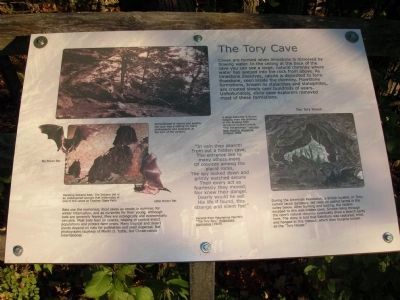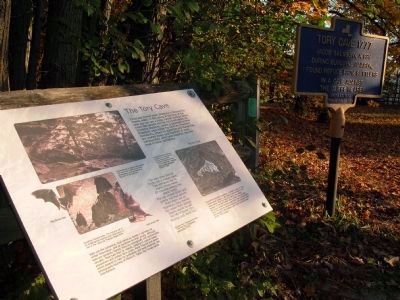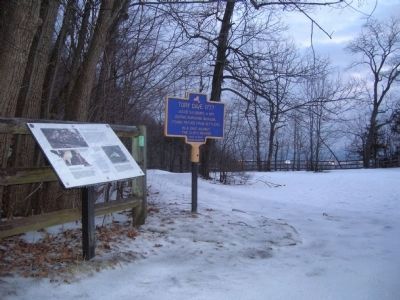Near Voorheesville in Albany County, New York — The American Northeast (Mid-Atlantic)
The Tory Cave
In vain they search!
From out a hidden cave,
The entrance like to many others more
Of crevices among the placid rocks,
The spy looked down and grimly watched secure
Their every act as fearlessly they moved;
Nor knew their danger.
Dearly would he sell
His life if found, this strange and silent foe!”
Excerpt from Magdalene Merritt’s “The Tory Spy,” Helderberg Harmonies (1909).
[The picture in the lower right has the following title and captions]:
A large stalactite is shown hanging from the chimney in this drawing from Verplanck Colvin’s article, “The Helderbergs,” Harpers New Monthly Magazine, October 1869.
During the American Revolution, a British loyalist, or Tory, named Jacob Salisbury, led raids on patriot farms in the valley below. After burning and looting, the raiders escaped to this well-hidden cave. Smoke rising through the cave’s natural chimney eventually drew a search party here. The story is told that Salisbury was captured, tried, and hanged in this hideout, which then became known as the “Tory House.”
Erected 1994 by New York State Education Department and Tawasentha Daughters of the American Revolution.
Topics and series. This historical marker is listed in these topic lists: Animals • Natural Features • War, US Revolutionary. In addition, it is included in the Daughters of the American Revolution series list. A significant historical month for this entry is October 1869.
Location. 42° 39.142′ N, 74° 0.735′ W. Marker is near Voorheesville, New York, in Albany County. Marker can be reached from Thacher Park Road (New York State Route 157). This marker is not viewable from the roadway. It is located beside the Indian Ladder Trail trailhead near the Indian Ladder Picnic Area within John Boyd Thacher State Park. Touch for map. Marker is at or near this postal address: 1 Hailes Cave Road, Voorheesville NY 12186, United States of America. Touch for directions.
Other nearby markers. At least 8 other markers are within 2 miles of this marker, measured as the crow flies. The Indian Ladder Trail (within shouting distance of this marker); Helderbergs (approx. ¼ mile away); Thacher Point (approx. 0.3 miles away); Tory Cave 1777 (approx. 0.3 miles away); Indian Ladder (approx. 0.3 miles away); Henry Crounse (approx. 1.3 miles away); Locust Vale School (approx. 1½ miles away); Knox School #5 (approx. 1.7 miles away). Touch for a list and map of all markers in Voorheesville.
More about this marker. In addition to the picture noted above, there are two other pictures on this marker. The first is of two women sitting near the entrance of the cave. It has the following caption, "Romanticized in stories and poems, the cave was a setting for many photographs and postcards at the turn of the century."
The other photo, in the lower left, is of Roosting Indiana Bats. Inset to this picture are two smaller pictures, on of a Big Brown Bat, and one of a Little Brown Bat. The bat photographs are provided for use on the marker courtesy of Merlin D. Tuttle, Bat Conservation International. These picture also carry the caption: "The Indiana bat is an endangered species that hibernates in one of the caves at Thacher State Park."
Bats use the numerous, local caves as roost in summer, for winter hibernation, and as nurseries for their young. Although bats are generally feared, they are ecologically and economically valuable. Most bats feed on insects, helping to control insect populations and protect farm crops. Many tropical and desert plants depend on bats for pollination and seed dispersal.
Additional keywords. John Boyd Thacher Park Indian Ladder Trail
Credits. This page was last revised on June 16, 2016. It was originally submitted on October 20, 2008, by Howard C. Ohlhous of Duanesburg, New York. This page has been viewed 3,157 times since then and 36 times this year. Photos: 1, 2. submitted on October 19, 2008, by Howard C. Ohlhous of Duanesburg, New York. 3. submitted on November 20, 2008, by Howard C. Ohlhous of Duanesburg, New York. • Kevin W. was the editor who published this page.


